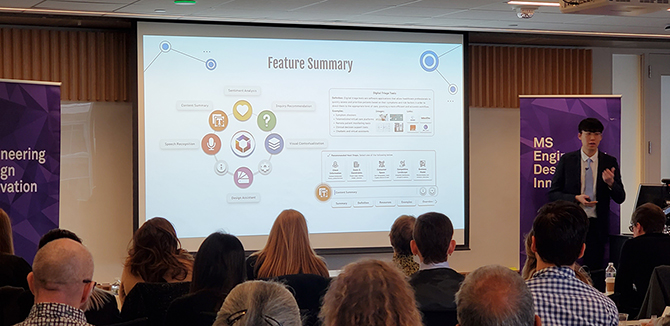Artist vs. AI? Try Artist and AI
David Du’s EDI thesis project aims to provide common ground among the distrust between creatives and artificial intelligence.

David Du (EDI '23) believes there are two types of creative professionals: those who are optimistic about how artificial intelligence (AI) can help their day-to-day work, and those who brush it off and reject the notion of it being a positive tool.
For his thesis project in Northwestern's Master of Science in Engineering Design Innovation (EDI) program, Du sought to bring those two viewpoints together.
Du designed the framework for AI-DA, short for AI-Designer's Assistant. The goal was to create an application that fostered a sense of familiarity and trust from creative types with AI.
“We have reached a point of no return in terms of the impact AI has left and will leave on the creative industry,” Du said. “Certain traditions and values that we used to hold dearly as creatives have simply been challenged and changed forever.”
Du wants to steer the change in a positive direction.
The idea for AI-DA was born in the summer of 2022 as Du became fascinated with AI text-to-image generation. This newfound technology put artists and creatives on their heels and ignited a debate over what exactly is art.
That debate ultimately sparked Du's thesis.
“How to rethink this seemingly broken relationship between AI and artists quickly became a potential thesis topic that I intended on exploring,” he said. “At the time, even that felt like too grand and complex of a problem to tackle.”
The idea behind AI-DA is to create an optimized user experience (UX) design process with a comprehensive feature set that meets the needs of a creative design team at every step of product or service development.
The goal is to bring designers and AI together to show how the former can benefit from the latter.
“By leveraging natural language processing and existing AI generation capabilities, AI-DA helps UX researchers and designers save valuable time and effort on repetitive, labor-intensive, non-scalable manual tasks,” Du said. “They can then focus instead on more novel, value-added, complex activities that demand human judgment and compassion, thus contributing toward more effective user-centered innovation.”
That type of collaborative innovation is the best potential for AI, Du said. In that scenario, humans focus on doing the things humans do best while letting technology take care of the things technology does best.
Du did not have extensive knowledge about AI prior to starting his work on AI-DA, but he said that's the beauty of the thesis project. Thesis is an integral part of the EDI program. It allows students to dive deeper on a topic they are passionate about and put the skills they have learned throughout the program – particularly those based on human-centered design – into practice.
Du said his thesis experience allowed him to do that.
It also provided him inspiration for the future.
"As AI continues to leave its imprint on the world around us, my work from thesis will surely continue to aid and motivate me (and hopefully my audience, too) to understand, adapt, and exploit these wonderful inventions," he said. "We are all a part of this AI revolution, it is crucial that we find our place within it.

